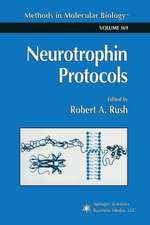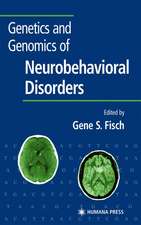Transgenic and Knockout Models of Neuropsychiatric Disorders: Contemporary Clinical Neuroscience
Editat de Gene S. Fisch, Jonathan Flinten Limba Engleză Hardback – mar 2006
| Toate formatele și edițiile | Preț | Express |
|---|---|---|
| Paperback (1) | 1218.21 lei 6-8 săpt. | |
| Humana Press Inc. – 9 noi 2010 | 1218.21 lei 6-8 săpt. | |
| Hardback (1) | 1223.88 lei 6-8 săpt. | |
| Humana Press Inc. – mar 2006 | 1223.88 lei 6-8 săpt. |
Din seria Contemporary Clinical Neuroscience
- 5%
 Preț: 655.42 lei
Preț: 655.42 lei - 18%
 Preț: 958.25 lei
Preț: 958.25 lei - 18%
 Preț: 1678.01 lei
Preț: 1678.01 lei - 18%
 Preț: 1403.22 lei
Preț: 1403.22 lei - 18%
 Preț: 1008.43 lei
Preț: 1008.43 lei - 5%
 Preț: 1407.87 lei
Preț: 1407.87 lei - 18%
 Preț: 1101.40 lei
Preț: 1101.40 lei - 18%
 Preț: 944.19 lei
Preț: 944.19 lei - 18%
 Preț: 1231.01 lei
Preț: 1231.01 lei - 5%
 Preț: 1105.95 lei
Preț: 1105.95 lei - 15%
 Preț: 644.30 lei
Preț: 644.30 lei - 5%
 Preț: 1173.82 lei
Preț: 1173.82 lei - 15%
 Preț: 641.03 lei
Preț: 641.03 lei - 18%
 Preț: 1239.19 lei
Preț: 1239.19 lei - 18%
 Preț: 1229.40 lei
Preț: 1229.40 lei - 18%
 Preț: 1110.24 lei
Preț: 1110.24 lei - 18%
 Preț: 1113.39 lei
Preț: 1113.39 lei - 18%
 Preț: 1225.94 lei
Preț: 1225.94 lei - 5%
 Preț: 1438.58 lei
Preț: 1438.58 lei - 15%
 Preț: 651.84 lei
Preț: 651.84 lei - 5%
 Preț: 1103.22 lei
Preț: 1103.22 lei - 18%
 Preț: 1402.55 lei
Preț: 1402.55 lei - 5%
 Preț: 1089.48 lei
Preț: 1089.48 lei - 18%
 Preț: 1828.60 lei
Preț: 1828.60 lei - 5%
 Preț: 1103.75 lei
Preț: 1103.75 lei - 18%
 Preț: 1407.46 lei
Preț: 1407.46 lei - 18%
 Preț: 951.47 lei
Preț: 951.47 lei - 18%
 Preț: 1385.37 lei
Preț: 1385.37 lei
Preț: 1223.88 lei
Preț vechi: 1492.53 lei
-18% Nou
Puncte Express: 1836
Preț estimativ în valută:
234.22€ • 244.22$ • 194.66£
234.22€ • 244.22$ • 194.66£
Carte tipărită la comandă
Livrare economică 20 martie-03 aprilie
Preluare comenzi: 021 569.72.76
Specificații
ISBN-13: 9781588295071
ISBN-10: 1588295079
Pagini: 296
Ilustrații: XII, 296 p. 20 illus.
Dimensiuni: 155 x 235 x 21 mm
Greutate: 0.62 kg
Ediția:2006
Editura: Humana Press Inc.
Colecția Humana
Seria Contemporary Clinical Neuroscience
Locul publicării:Totowa, NJ, United States
ISBN-10: 1588295079
Pagini: 296
Ilustrații: XII, 296 p. 20 illus.
Dimensiuni: 155 x 235 x 21 mm
Greutate: 0.62 kg
Ediția:2006
Editura: Humana Press Inc.
Colecția Humana
Seria Contemporary Clinical Neuroscience
Locul publicării:Totowa, NJ, United States
Public țintă
ResearchCuprins
and Overview.- Transgenic and Knockout Models of Psychiatric Disorders.- Transgenic Mouse Models and Human Psychiatric Disease.- Transgenic and Knockout Mouse Models.- If Only They Could Talk.- Transgenic and Knockout Models of Neurocognitive Dysfunction.- Spinocerebellar Ataxia Type 1.- Mouse Models of Hereditary Mental Retardation.- How Can Studies of Animals Help to Uncover the Roles of Genes Implicated in Human Speech and Language Disorders?.- Animal Models of Autism.- Transgenic and Knockout Models of Neuropsychiatric Dysfunction.- Genetic Mouse Models of Psychiatric Disorders.- Animal Models of Psychosis.- Animal Models of Anxiety.- Modeling Human Anxiety and Depression in Mutant Mice.- Mutant Mouse Models of Bipolar Disorder.
Textul de pe ultima copertă
Neuroscientists are now establishing meaningful genotype-phenotype relationships for complex neurobehavioral and neuropsychiatric disorders and even creating animal models for these dysfunctions. These developments have made it imperative to know when such transgenic and knockout models are valid for the human disorders they represent. In Transgenic and Knockout Models of Neuropsychiatric Disorders, a panel of leading researchers comprehensively assesses how and whether the genetic abnormalities produced from these models manifest the neuropsychiatric disorders to which they correspond. The authors focus on transgenic and knockout models of neurocognitive dysfunction and neuropsychiatric dysfunction. The discussion of neurobiological problems covers mental retardation, polyglutamate, as well as speech disorders, and disorders that involve cognitive, social, speech, and language dysfunction. The neuropsychiatric dysfunctions examined include psychosis and schizophrenia, anxiety, depression, and bipolar disorder. Timely introductory articles debate the alleged continuity of species of human and infrahuman behavior (Darwin), the utility of infrahuman animals in understanding human behavior and psychiatric disease, and the suitability of nonhuman models of complex neuropsychiatric dysfunctions involving language.
Comprehensive and systematic, Transgenic and Knockout Models of Neuropsychiatric Disorders offers a clear assessment of whether genetic abnormalities produced from infrahuman models manifest the neuropsychiatric disorders to which they correspond in humans and how best they may be used to carry out successful research today.
Comprehensive and systematic, Transgenic and Knockout Models of Neuropsychiatric Disorders offers a clear assessment of whether genetic abnormalities produced from infrahuman models manifest the neuropsychiatric disorders to which they correspond in humans and how best they may be used to carry out successful research today.
Caracteristici
Includes supplementary material: sn.pub/extras




















